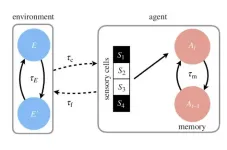(Press-News.org) A drug commonly used to treat glaucoma has been shown in zebrafish and mice to protect against the build-up in the brain of the protein tau, which causes various forms of dementia and is implicated in Alzheimer’s disease.
Researchers in the UK Dementia Research Institute at the University of Cambridge screened more than 1,400 clinically-approved drug compounds using zebrafish genetically engineered to make them mimic so-called tauopathies. They discovered that drugs known as carbonic anhydrase inhibitors – of which the glaucoma drug methazolamide is one – clear tau build-up and reduce signs of the disease in zebrafish and mice carrying the mutant forms of tau that cause human dementias.
Tauopathies are neurodegenerative diseases characterised by the build-up in the brain of tau protein ‘aggregates’ within nerve cells. These include forms of dementia, Pick's disease and progressive supranuclear palsy, where tau is believed to be the primary disease driver, and Alzheimer’s disease and chronic traumatic encephalopathy (neurodegeneration caused by repeated head trauma, as has been reported in football and rugby players), where tau build-up is one consequence of disease but results in degeneration of brain tissue.
There has been little progress in finding effective drugs to treat these conditions. One option is to repurpose existing drugs. However, drug screening – where compounds are tested against disease models – usually takes place in cell cultures, but these do not capture many of the characteristics of tau build-up in a living organism.
To work around this, the Cambridge team turned to zebrafish models they had previously developed. Zebrafish grow to maturity and are able to breed within two to three months and produce large numbers of offspring. Using genetic manipulation, it is possible to mimic human diseases as many genes responsible for human diseases often have equivalents in the zebrafish.
In a study published today in Nature Chemical Biology, Professor David Rubinsztein, Dr Angeleen Fleming and colleagues modelled tauopathy in zebrafish and screened 1,437 drug compounds. Each of these compounds has been clinically approved for other diseases.
Dr Ana Lopez Ramirez from the Cambridge Institute for Medical Research, Department of Physiology, Development and Neuroscience and the UK Dementia Research Institute at the University of Cambridge, joint first author, said: “Zebrafish provide a much more effective and realistic way of screening drug compounds than using cell cultures, which function quite differently to living organisms. They also enable us to do so at scale, something that it not feasible or ethical in larger animals such as mice.”
Using this approach, the team showed that inhibiting an enzyme known as carbonic anhydrase – which is important for regulating acidity levels in cells – helped the cell rid itself of the tau protein build-up. It did this by causing the lysosomes – the ‘cell’s incinerators’ – to move to the surface of the cell, where they fused with the cell membrane and ‘spat out’ the tau.
When the team tested methazolamide on mice that had been genetically engineered to carry the P301S human disease-causing mutation in tau, which leads to the progressive accumulation of tau aggregates in the brain, they found that those treated with the drug performed better at memory tasks and showed improved cognitive performance compared with untreated mice.
Analysis of the mouse brains showed that they indeed had fewer tau aggregates, and consequently a lesser reduction in brain cells, compared with the untreated mice.
Fellow joint author Dr Farah Siddiqi, also from the Cambridge Institute for Medical Research and the UK Dementia Research Institute, said: “We were excited to see in our mouse studies that methazolamide reduces levels of tau in the brain and protects against its further build-up. This confirms what we had shown when screening carbonic anhydrase inhibitors using zebrafish models of tauopathies.”
Professor Rubinsztein from the UK Dementia Research Institute and Cambridge Institute for Medical Research at the University of Cambridge, said: “Methazolamide shows promise as a much-needed drug to help prevent the build-up of dangerous tau proteins in the brain. Although we’ve only looked at its effects in zebrafish and mice, so it is still early days, we at least know about this drug’s safety profile in patients. This will enable us to move to clinical trials much faster than we might normally expect if we were starting from scratch with an unknown drug compound.
“This shows how we can use zebrafish to test whether existing drugs might be repurposed to tackle different diseases, potentially speeding up significantly the drug discovery process.”
The team hopes to test methazolamide on different disease models, including more common diseases characterised by the build-up of aggregate-prone proteins, such as Huntington’s and Parkinson’s diseases.
The research was supported by the UK Dementia Research Institute (through UK DRI Ltd, principally funded through the Medical Research Council), Tau Consortium and Wellcome.
Reference
Lopez, A & Siddiqi, FH et al. Carbonic anhydrase inhibition ameliorates tau toxicity via enhanced tau secretion. Nat Chem Bio; 31 Oct 2024; DOI: 10.1038/s41589-024-01762-7
END
Glaucoma drug shows promise against neurodegenerative diseases, animal studies suggest
2024-10-31
ELSE PRESS RELEASES FROM THIS DATE:
Human proteins identified that explain inter-individual differences in functional brain connectivity
2024-10-31
BIRMINGHAM, Ala. – A long-standing goal of neuroscience is to understand how molecules and cellular structures on a microscale give rise to communication between brain regions at the macroscale. A study published in Nature Neuroscience now identifies, for the first time, hundreds of brain proteins that explain inter-individual differences in functional connectivity and structural covariation in the human brain.
“A central goal of neuroscience is to develop an understanding of the brain that ultimately describes the mechanistic basis of human cognition and behavior,” said Jeremy Herskowitz, Ph.D., associate professor in the University of Alabama at Birmingham ...
A newly developed algorithm shows how a gene is expressed at microscopic resolution
2024-10-31
They say a picture is worth a thousand words.
A new method, developed by University of Michigan researchers, creates images that are worth many gigabytes of data, which could revolutionize the way biologists study gene expression. Seq-Scope, developed by Jun Hee Lee, Ph.D., Hyun Min Kang, Ph.D., and their colleagues, was first described in Cell in 2021 as the first method to analyze gene expression at sub micrometer-scale spatial resolution.
To compare, a single human hair ranges from 20 to 200 micrometers in width.
The team has since improved Seq-Scope, making it more versatile, ...
Why elephants never forget but fleas have, well, the attention span of a flea
2024-10-31
Researchers at the Complexity Science Hub and Santa Fe Institute have developed a model to calculate how quickly or slowly an organism should ideally learn in its surroundings. An organism’s ideal learning rate depends on the pace of environmental change and its life cycle, they say.
Every day, we wake to a world that is different, and we adjust to it. Businesses face new challenges and competitors and adapt or go bust. In biology, this is a question of survival: every organism, from bacteria to blue whales, faces the challenge of adapting to environments that ...
Childhood neglect associated with stroke, COPD, cognitive impairment, and depression
2024-10-31
Toronto, ON, – New research from the University of Toronto found that childhood neglect, even in the absence of childhood sexual abuse and physical abuse, is linked with a wide range of mental and physical health problems in adulthood.
“While a large body of research has established the detrimental impact of childhood physical and sexual abuse on adult health outcomes, much less is known about whether neglect, in the absence of abuse, has similar negative outcomes,” said first author, Linxiao Zhang, a PhD student at the Factor-Inwentash Faculty of Social Work (FIFSW) at the University of Toronto. “Our research underlines the importance of health professionals ...
Landmark 20-year study of climate change impact on permafrost forests
2024-10-31
In perhaps the first long-term study of CO2 fluxes in northern forests growing on permafrost, an Osaka Metropolitan University-led research team has found that climate change increased not only the sources of carbon, but also the CO2 sinks.
The 20-year observation from 2003-2022 in the interior of Alaska showed that while CO2 sinks turned into sources during the first decade, the second decade showed a nearly 20% increase in CO2 sinks.
Graduate School of Agriculture Associate Professor Masahito Ueyama and colleagues found that warming led to wetness, which in turn aided the growth of black spruce trees. During photosynthesis, the growing trees were using the increasing ...
Researchers take broadband high-resolution frequency combs into the UV
2024-10-31
WASHINGTON — Researchers have developed a new ultrafast laser platform that generates ultra-broadband ultraviolet (UV) frequency combs with an unprecedented one million comb lines, providing exceptional spectral resolution. The new approach, which also produces extremely accurate and stable frequencies, could enhance high-resolution atomic and molecular spectroscopy.
Optical frequency combs — which emit thousands of regularly spaced spectral lines — have transformed fields like metrology, spectroscopy and precision timekeeping via optical atomic clocks, earning the 2005 Nobel Prize in Physics.
The ...
Not going out is the “new normal” post-Covid, say experts
2024-10-31
Compared with just before the Covid-19 pandemic, people are spending nearly an hour less a day doing activities outside the home, behaviour that researchers say is a lasting consequence of the pandemic.
A new study published in the peer-reviewed Journal of the American Planning Association reveals an overall drop since 2019 of about 51 minutes in the daily time spent on out-of-home activities, plus an almost 12-minute reduction in time spent on daily travel such as driving or taking public transportation.
The analysis, based on a survey of 34,000 Americans, ...
Study shows broader screening methods help prevent spread of dangerous fungal pathogen in hospitals
2024-10-31
Study Shows Broader Screening Methods Help Prevent Spread of Dangerous Fungal Pathogen in Hospitals
Screening high-risk patients for Candida auris allows for early detection and implementation of infection control measures to prevent hospital outbreaks
Arlington, Va. — October 31, 2024 — A new study published today in the American Journal of Infection Control (AJIC) describes the outcome of a shift in hospital screening protocols for Candida auris, a dangerous and often drug-resistant fungal pathogen that spreads easily in hospital environments. A comparison of screening results and patient outcomes before ...
Research spotlight: Testing a model for depression care in Malawi using existing medical infrastructure
2024-10-31
How would you summarize your study for a lay audience?
We tested a model of depression care in Malawi, a low-income country in sub-Saharan Africa, that builds off the infrastructure of the country’s HIV delivery system. The intervention involved clinical officers who delivered medications for depression, and it involved lay personnel, people living in the community, to deliver psychotherapy. Unlike past research, we did not limit our evaluation to improvements in depression; we also looked at improvements in other chronic health conditions that participants had, and we measured effects on household members.
What knowledge gap does your study help to ...
Depression care in low-income nations can improve overall health
2024-10-31
Treating people in low-income countries for major depressive disorder can also help improve their physical health and household members’ wellbeing, demonstrating that mental health treatments can be cost effective, according to a new RAND study.
Researchers examined a program in the sub-Saharan nation of Malawi that builds off the infrastructure of the country’s HIV care system and trains local people in rural communities to help treat people who suffer from depression.
The study found participants had significant improvements in their depression symptoms, ...



